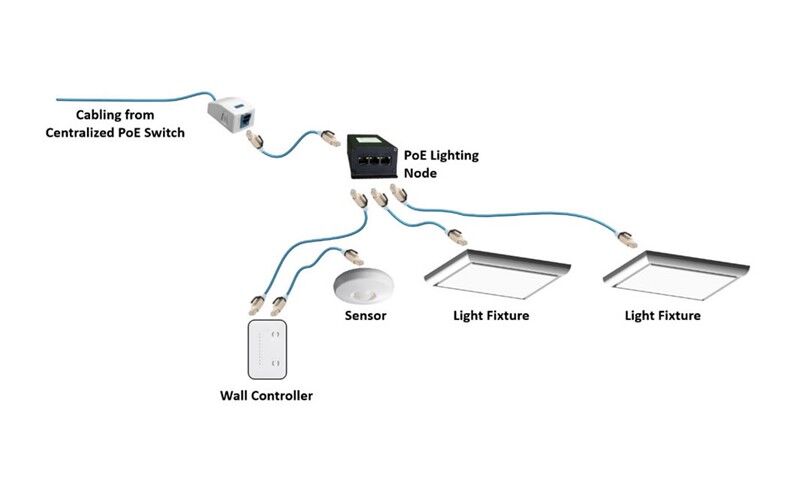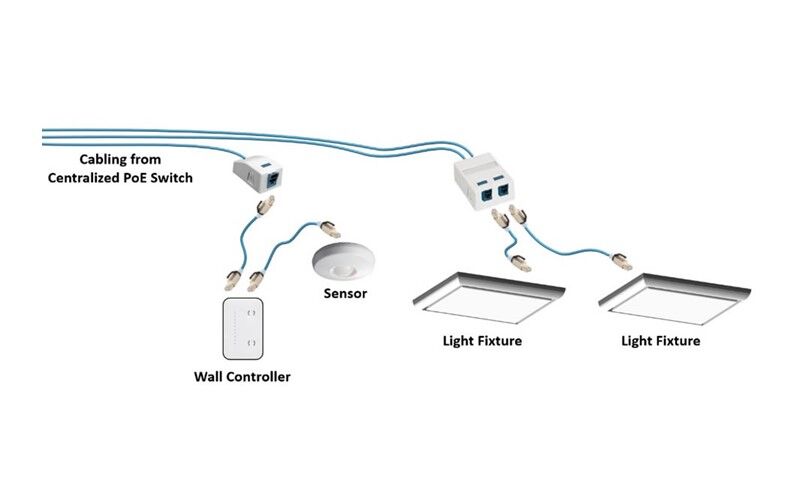Low-voltage light-emitting diode (LED) lighting started to gain ground in the early 2000’s for niche applications, and by 2015, it had become the primary lighting technology in commercial construction due to significantly reduced energy consumption, environmentally-friendly fixtures and control capabilities. When higher levels of power over Ethernet (PoE) came on the scene with Cisco’s Universal Power Over Ethernet (UPOE), followed shortly thereafter by IEEE 802.3bt four-pair PoE, it became possible to deliver enough power over network structured cabling to support LED lights. That’s when connecting and powering lights over IP-based networks really started to take off, opening up a whole new world of possibilities.
Lighting as a Technology Platform
The benefits of PoE lighting now go far beyond the energy savings, environmental advantages and control capabilities of LEDs. As IP-based devices that reside on the network, PoE light fixtures can be controlled and managed via software from anywhere and integrated with other network applications. Because lighting is ubiquitous throughout every commercial facility, it also has established the ideal network-based platform for pervasive advanced sensor technology that enables embedding intelligence into every fixture to collect and share actionable data with other connected systems. And the possibilities are endless!
It’s no longer just occupancy sensing, daylight harvesting, and color and illumination adjustment for the task at hand. Modern-day PoE lighting systems can be outfitted with a wide range of sensors for everything from temperature, humidity and pressure, to gases, movement and even gun shots. Through integration with other building systems like HVAC and security, PoE lights can share the data they collect via sensors for everything from automatically adjusting air quality and comfort, to detecting health and security threats, controlling crowds and optimizing operations.
As PoE lighting systems continue to gain momentum in the marketplace, there are also a greater number of lighting vendors and broader selection of fixtures-from common 2X2 troffers for drop-ceiling office environments, to task oriented and ornate architectural lights. In fact, the PoE lighting market is one of the fastest growing markets at an annual growth rate of more than 35%, expected to reach nearly $2 billion by 2024 in the U.S. alone. But with this epic popularity and multiple vendors also comes multiple types of PoE lighting systems that are not necessarily all configured the same.
System Design Considerations
In a PoE lighting system, lighting fixtures can be connected directly to the network or via nodes that connect to the network and branch power and data off to one or more fixtures. The systems can also be centralized with fixtures or nodes connecting back to network PoE switches in telecommunications rooms, or they can be decentralized and connected to smaller switches placed close to groups of fixtures or nodes, typically in the ceiling space.
While selecting a PoE lighting vendor has a lot to do with the fixture product line, and some projects may even warrant selecting multiple vendors, it’s important to also consider the configuration based on your needs and the following considerations:

Node-Centric systems can provide some flexibility in that they can potentially be used to connect to devices other than lighting (i.e., automatic shades), and they may support daisy-chaining of lower-power sensors, dimmers, controllers or other lighting components, offering the benefit of fewer cabling runs from the switch
Fixture-Centric systems are less likely to support extensive daisy-chaining, but some systems do enable controller and sensor daisy-training. While these systems do result in more cabling runs, and therefore require more switch ports and pathway space, they offer a more centralized management approach and can deliver higher levels of remote powering to devices. This is a consideration for high-lumen lights deployed in high-bay areas (i.e., gymnasiums, warehouses, etc.) and future technologies that may require more power that supported by a node.

Fixture-centric systems also better facilitating mixing and matching vendors rather than ending up with a node that may only support that vendor’s fixtures. Furthermore, as technology evolves, upgrading a single network switch in the TR to deliver more power or support faster transmission speeds is likely easier than upgrading multiple nodes in the ceiling space.
Choosing between a centralized and decentralized system comes with additional considerations, including space availability, staffing resources, maintenance procedures and backup power. And there are even considerations surrounding remote power delivery-not all networked LED lighting systems have to be powered via PoE. You also need to deploy a well-designed, high-performance and reliable cabling infrastructure backed by experienced industry PoE lighting experts-because without it, you might find yourself in the dark.





